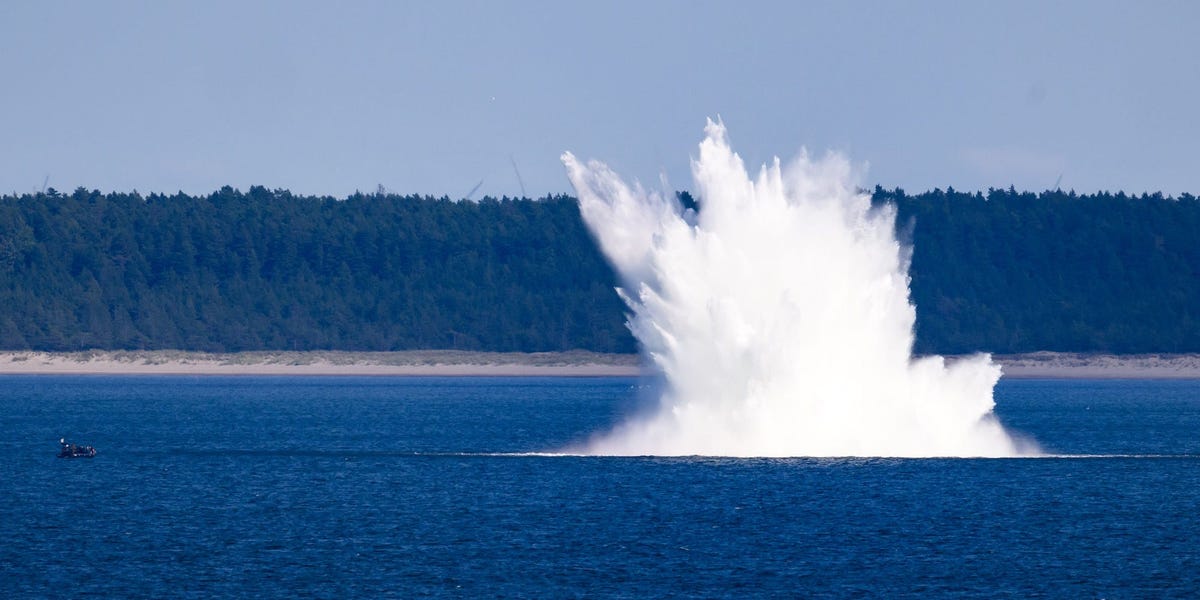Finding and disposing of mines on the sea floor presents significant dangers and complexities. The US Navy is pursuing robotic crawlers that can dive to nearly 2,000 feet under the water to tackle this challenge. This initiative extends beyond the capabilities of existing technologies developed by contractors like Textron.
Naval mines pose a serious threat in maritime conflicts. These rudimentary yet explosive devices lie hidden on the seabed, functioning similarly to improvised explosive devices (IEDs) while being far more challenging to detect and remove than their floating counterparts. Historically, combating these mines has relied on ships, specialized sleds towed by helicopters, and specially trained personnel. However, the Navy is now reimagining this critical task with a robotic solution.
The Navy envisions a compact unmanned vehicle, weighing no more than 150 pounds. As outlined in a December Navy Small Business Innovation Research (SBIR) solicitation, this “Maritime Expeditionary Response Crawler” would be equipped with various payloads, including sensors for short-range detection, manipulative arms, and tools designed to disrupt mines and other underwater explosives.
The envisioned crawler would feature both autonomy and manual control via a tether. According to the SBIR, it must conduct operations at depths exceeding 600 meters (approximately 1,968 feet) and navigate at the ocean surface for at least two nautical miles before it can autonomously submerge to the seabed. This design promotes a standoff capability, allowing operators to maintain a safe distance from potential explosive threats. Upon reaching the sea floor, the crawler would deploy a tethered buoy with a radio transmitter that communicates with the mothership.
This operation is expected to automate the tedious and hazardous task of mine sweeping. The SBIR states that “supervisory autonomy” to lessen the cognitive load on operators is preferred. Nonetheless, operators will retain control for situational awareness and the ability to detect, reacquire, and mitigate naval mines and other explosive threats.
The crawler will need to perform effectively across various sediment and seabed types, including rocky, sandy, and silty environments, and remain stable amid dynamic sea conditions. While bottom mines are usually placed in shallow waters, the focus on ocean conditions rather than river environments reflects the crawler’s intended operational scope.
Naval mines have a notorious reputation as stealthy and treacherous weapons, dating back to ancient Chinese warfare. Modern iterations were pioneered by American inventor David Bushnell during the Revolutionary War. Among historical designs, moored mines are the most common, tethered to the sea floor with cable to float at a determined depth. The simplest type, the contact mine, detonates upon contact with any vessel, whether military or civilian, which underscores the indiscriminate nature of mine warfare.
In 2023, a naval mine was intentionally detonated for training purposes during a NATO maritime exercise in the Baltic Sea.
Bottom mines, however, operate quietly until activated by a ship’s magnetic field, the sound of its propellers, or the pressure exerted by the vessel. Although moored mines can also utilize these activation mechanisms, bottom mines prove more challenging to detect. Additionally, they tend to carry larger explosive charges since their shockwaves must focus upwards to impact vessels above, which is why they are typically found in relatively shallow waters (less than 164 feet), according to the Strauss Center for International Security.
Countries like Russia, the US, and China deploy bottom mines—examples include Russia’s MDM, the US Navy’s Quickstrike, and China’s Chen series. Notably, Chinese military publications indicate a preference for bottom mines due to their reliability against the challenges posed by current and wave disturbances, as pointed out by American defense analyst Lyle Goldstein.
The trend of utilizing robotics in mine clearance is already underway, with the US Navy recently granting Textron a $106 million contract for semi-autonomous mine-clearing boats. The SeaFox, a drone designed for single-use, has been operational since 2001 as employed by the Royal Navy.
Nevertheless, the introduction of a robotic underwater crawler would mark a significant evolution in naval mine warfare. Although the SBIR outlines a primary focus on mines and explosives, such technology could serve as a valuable tool for safeguarding undersea infrastructure against sabotage. Concerns over the security of such critical infrastructure—often located hundreds of feet beneath the surface—continue to grow.
Incidents like the exploitation of telecommunications cables by ships dragging anchors and the September 2022 explosions damaging the Nord Stream 1 and 2 pipelines draw attention to these vulnerabilities. NATO has since advanced surveillance measures through drones and sensors to secure undersea assets within the Baltic and Mediterranean Seas, making the development of a robotic crawler for mine clearance seem like an advantageous evolution.
Michael Peck is a defense writer whose work has been published in Forbes, Defense News, Foreign Policy magazine, and other respected platforms. He holds a Master’s degree in political science from Rutgers University and can be followed on Twitter and LinkedIn.








